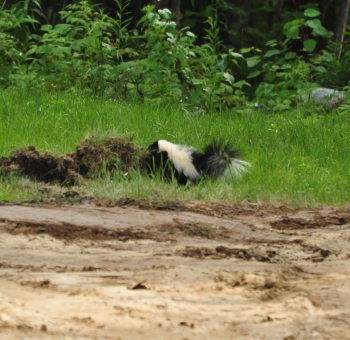 With large sections of our front yard floating out onto the driveway with each rainfall, landscaping became an urgent priority. Agriculturally challenged, we hired a local company that does exceptional work with designs that are very much in keeping with New England tradition. The work activity, unfortunately, has drawn the attention of a local skunk.
With large sections of our front yard floating out onto the driveway with each rainfall, landscaping became an urgent priority. Agriculturally challenged, we hired a local company that does exceptional work with designs that are very much in keeping with New England tradition. The work activity, unfortunately, has drawn the attention of a local skunk.
The skunk, we’ll call him “Pepe”, has persisted in trying to establish an amorous relationship with some of the more attractive dirt clumps turned up by the Bobcat. Sadly, the clumps appear to want no part of him. My wife thinks Pepe might be rabid, but I think he’s just living the lonely life of a skunk. Women wouldn’t understand, but I think most men can relate to Pepe’s plight.
Oh yes, reloading presses. Sorry…
The following represents general descriptions of various types of manual reloading presses. It is not intended to be a mass product review or to tout the virtues of any one brand or model. Rather it is intended to show some of the ways presses differ within a single category and to possibly define some hardware characteristics that might be worth examining before making an equipment purchase. Regardless the choice, press selection should typically be preceded by defining what sort of a reloading environment is to exist; how many rounds will be produced in what time frame and what are the largest and smallest extremes in cartridges planned. It isn’t possible to reload a 50 BMG with a RCBS Partner Press and it is not optimal to reload .380 ACP cases with a long stroke Redding Ultra Mag Press. With light loading of a limited number of mainstream cartridges, an under $100 reloading kit may be all that is required. The same press with with 500 rounds of reloading on the day’s agenda could represent pending exhaustion. With those thoughts in mind –

When I began reloading, things were different. The wheel was the hot new technology, “The Flintstones” show was being broadcast live and basic reloading tools were lying about for the taking (see the original Rock Chucker pictured above). The basic process to be served was, and remains: remove the spent primer, cold form the case back to some standard dimension, insert an appropriate fresh primer, charge the case with a proper amount and type of powder, and seat an appropriate bullet to the proper depth. The job of the reloading press is to hold tools, such as a die set and other accessories, in proper orientation to the materials being assembled, to provide efficient transport of components and tools within the process and to provide mechanical advantage to reduce required operator effort. The degree of efficiency of transport and ease of operation will, for the most part, determine cost. Acceptable cost is determined by budget and specific application.
A reloading system and a sandwich to go for under $25… Includes dies

Lee Precision products are always interesting in design, always well thought out and always inexpensive. Within their intended purpose they can be excellent. To the right is a complete reloading system. Yes, really. In fact, add bullets, powder and primers, bang on it with a plastic headed hammer, you’re good to go for reloading the .45-70 Gov’t, or any of twenty one standard, magnum, rifle and handgun cartridges listed under the Classic Lee Loader. While there are a number of limitations, assembled cartridge accuracy is not one of them. With the right components, as would be the case regardless the dies and assembly tools, building sub MOA ammo is easier than just doable.
Fundamentally, a hammer provides the compressing force normally supplied by a reloading press. Want to increase the mechanical advantage behind the effort? Get a heavier hammer with a longer handle and wonk away. The shiny chrome tool is a combination die body and, when used in combination with the other adaptive tools in the kit, duplicates the functions of a full die set. How cool is that? The Classic Lee Loader neck sizes only, so its use is pretty much restricted to loading for the same gun that produces the empty brass. There is no facility to expand straight walled cases or flare case mouths so cast bullets may be difficult to load without the separate purchase of an expander.
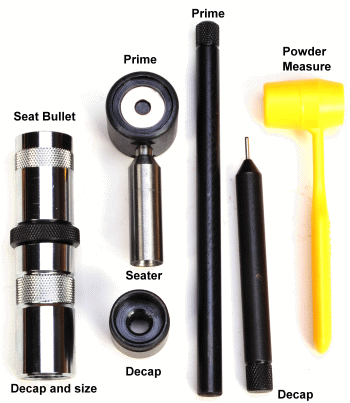
Ammo produced by the .45-70 Gov’t version of the Classic Lee Loader yielded handloads for a lever action rifle that chambered and extracted without difficulty. Accuracy of assembled ammunition was good as long as I exercised care during the process. Care in this case means a loading rate limit that pegs out at twenty five to thirty rounds per hour even when utilizing very organized batch processing.
Tap out a primer, tap a case in the die body for sizing, use the priming chamber to prime, use the measure to charge, seat a bullet, tap again to crimp. Easy, but the operation quickly become tedious and production limitations surfaced within a very short period of time.
The Classic Lee Loader is absolutely worth a few bucks as a learning aid for a person who is curious about handloading and wants to learn more before making a more significant financial commitment. It is not a very practical piece of equipment beyond that point. Neck sizing is not optimal for hunting ammo and loading more than a couple of boxes of ammo at a single sitting would make most people heads fall off their shoulders. As a back packing tool, I’d have to wonder about the space and weight efficiency as enough bullet and other components to justify carrying a press would also be required.
Hand Presses… $70 – $110 with dies
Some hand type presses have been around for over one hundred years. The Lyman 310 is sold as dies (tools) and requires small or large handle sets to complete the system. The 310 tool sets run approximately twice the price of the Lee Classic Loader and a set of required handles doubles that amount making this relatively limited tool rather expensive. The 310 is a neck sizer only and has no means to measure powder within the kit. Tools are not 7/8″x14 standard, so cartridge loading choices are limited and since single hinged handles holds the tools, all motions are in a significant arc rather than lined up on the longitudinal axis of the ammunition. Unless there is a need to reload with a nostalgic flare, these are relatively expensive tools and will not produce the best ammo. But look on the bright side, they may be expensive, but they are also difficult to use.

In a number of respects the Lee Hand Press is better than the Lyman 310 and the little hammer headed Classic Lee Loader. The ram axis is in alignment with ammunition centerline and the hand press utilizes standard 7/8″x14 dies and shell holders. Since Lee die sets are generally supplied with powder measures and shell holders, a Lee Hand Press can be put into service for only about twice the price of the Classic Lee Loader. A press mounted priming tool may be configured to install either large and small primers.
The Lee Hand Press would truly make sense as a compact loader where space and weight are at a premium. No one likes to hear, “Get that stuff off the kitchen table so the kids can eat diner”. It is a step up from previously noted equipment because it does bring substantially greater mechanical advantage to the process, which reduces required effort and adds full length resizing capability. As a second class lever assembly (that’s not a cheap shot, it is a term for a lever where the resistance resides between a fulcrum and the effort), the hand press provides a 4.5:1 mechanical advantage. Knocking off 50 rounds of .40 S&W ammo in batch process fashion did not require the full extent of my athletic prowess, nor was a nappy required at the conclusion of that physical effort. I took the hand press out to the range when I was working on some handgun bullet penetration testing and it was pretty convenient to load at the shooting bench. Yes, this is a real piece of reloading equipment. No, it is not intended to produce lots of ammo.
Single Stage Presses $120 – $200 with dies
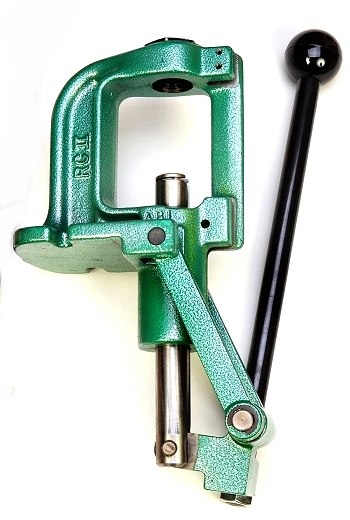
For many people, the single stage press is the icon of handloading. A single stage press can consistently produce precision ammunition and it can also be the least expensive piece of equipment, which makes for an interesting intersection of objectives. A single stage press can be compact and light for travel or it can be boulder heavy and destined never to leave a bench top. In compact form they can efficiently load handgun cartridges. In long form they can load big and dangerous game cartridges and that spiffy plinker, the 50 BMG.
A single stage press has a single die mounting station and a single position shell holder; nothing goes anywhere other than up and down. Single stage presses typically offer the benefits of a strong frame and few moving parts that might introduce instability, or inconsistency.
Single stage presses represent the next step up in quantity of production over previously noted presses. All single stage presses are not created equal, even though they may have a similar appearance. The differences have a tangible impact on ease of use and/or quality of output.

The presses pictured above, a Lee Breech Lock Challenger and an RCBS RockChucker II are both used in our shop for different circumstances. The RCBS Rock Chucker II has since evolved into the “Supreme” model which sounds a bit uptown for me, but it approximates the same major hunk of cast iron that makes this series operating effort low and extends the press window to a full 4″ inches to accommodate the longest cartridges. The differences in frame mass, ram diameter, linkage, and even handle length is quite obvious. Both are “O” frame types. Other “O” type presses are the Lee Cast Classic, Redding’s Boss and Big Boss II, Hornady’s Load N Load Classic and the RCBS Partner Press. Where the front side of the frame is open, like the Redding Ultra Mag or Sinclair International’s Bench Rest, they are referred to as “C” type presses. As a design they are not as strong as the “O” press, but considering the amount of force they typically need to exert to process ammo, they are many times stronger than required.
For the mainstream handloader with a few hundred rounds of mixed rifle and pistol ammo to load each month, or for very controlled load development rounds with lots of varying components, or even for portable applications, the right press within this collection could work well. The RCBS Rock Chucker series and the Redding units are very heavy duty and they have the additional feature of a removable die station bushing which permits use of either 7/8″x14 dies or 1¼” x 12 specialty dies and press mounted accessories. The Lee press, cast from aluminum, is lighter duty and great for travel or where space is limited. The table below indicates some ways in which single stage presses are differentiated by manufacturers as a reflection of strength and capacity.
| Dimensions & Characteristics | Lee Breech Lock | Rock Chucker |
| MSRP | $75 | $185 |
| Type | Single Stage | Single Stage |
| Frame Material | Cast Aluminum | Cast iron |
| Weight | 4 lbs 10 oz | 16 lbs 4 oz. |
| Die sizes accommodated | 7/8″x14 | 7/8″x14 and 1¼”x12 |
| Mechanical advantage – Measured | 3.25:1 | 6.5:1 |
| Press Window Height | 4″ | 3 5/8″ |
| Ram Diameter | 0.840″ | 1.000″ |
| Ram Stroke | 3 1/2″ | 3 7/8″ |
| Ram Support Bearing Surface | 5.3 sq.in. | 12.6 sq.in. |
| Ram Side Play Top of Stroke | 0.008″ | 0.004″ |
| Ram Side Play Bottom of Stroke | 0.004″ | 0.002″ |
| Die Head to Ram Centerline Offset | <0.002″ | <0.002″ |
All of the presses noted on the table and in the preceding text are precise in operation. Considering they are all mass produced and relatively inexpensive machined castings, this is quite an accomplishment. There are proprietary differences as each manufacturer has its own priming and powder charging systems, as well as little tweaks to die design, but each will also work with many of their competitors’ tools and accessories, permitting handloaders to pick the best of each for their specific application.
The RCBS Rock Chucker’s high mechanical advantage and greater mass keeps it on my bench for short runs. It takes approximately 85 lbs of effort at the shell holder to full length size and neck expand almost every case from the .45-70 Gov’t to the .40 S&W. The Rock Chucker’s greater mechanical advantage reduces this to less than 13 lbs of effort at the handle, where double that amount is required with the Lee Breech Lock. Priming takes less than half this amount of effort, but the Rock Chucker has a much more controlled feel throughout the seating cycle where the Lee starts with very high effort which removes much of the feel from the rest of the seating cycle. Again, I use both presses successfully, but if I have to sit in one spot and crank on a handle for a while I use the Rock Chucker. When on the road, I typically use the Lee press.
If a die changing contest were held…
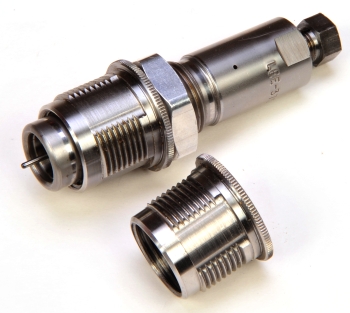
In response to the primary limitation of a single stage press, some manufacturers have improvised with quick change die systems. For anyone who has used a single stage press to load a large variety of cartridges at a single setting, they probably noticed that their fingers look like Popeye’s forearms at the end of the day.
The proprietary Lee Breech Lock bushing, pictured right, is an interrupted thread design that goes in an out of the press with a quarter twist of the bushing. Initially, a bushing is installed in the press, a die is screwed into the bushing and conventionally adjusted. From that point on, the push of a spring loaded release button and a quick twist removes and installs the die/bushing assembly, always pre-adjusted and ready to go. The Hornady system is very similar in function, only instead of interrupted threads it uses a series of radial locking lugs to accomplish the same quick twist remove and install. As the a Lock N Load bushings install in a 1 1/4″x12 thread, the system can be used not only on Hornady presses, but also on RCBS and Redding single stage equipment which support this bushing size. Regardless the quick change scheme, both systems allow a bushing to be left in place and standard dies installed and adjusted in a conventional fashion. Owning a press equipped with either of these systems does not force its use or require proprietary dies and accessories. Lee bushings cost approximately $10 for a set of two and Hornady Lock N Load, about $12 for a set of three.
Forster takes a different approach that is not bushing based but rather a snap in and out die mounting system that is integral to their unique CO-AX reloading press. The press utilizes standard dies sets and works with most manufacturers’ die locking rings and Forster rings work with all standard 7/8″x14 die sets. While I’d like to make this a complicated and convoluted system explanation, the press basically has a die holding “T” slot cast into the die head. Smart. The CO-AX press is approximately a $260 product.
All press types listed to this point are geared to batch processing where a bunch of ammo is run through each progressive until the entire batch ends up as finished ammo. Because of this, when I was recently looking for a single press to load a broad cross section of handgun and rifle ammo, big and small, in quantities in excess of a few hundred rounds a month I looked at the next press type.
Big boy presses… $150 – $300 with dies
A turret press is a significant step above a single stage press in terms of improving material and tooling transport efficiency. With a turret press, there is the same single position shell holder, however, the rotating turret head permits concurrent installation of multiple dies and die sets and the operator may position the head to follow any desired sequence of operation. A turret press can be used to batch process, where the press’ primary benefit is in having all dies in place and adjusted, ready to be rotated into position as needed. A turret press can also be used for sequential assembly where each individual cartridge can be assembled from start to finish by leaving it in the shell holder and moving the turret head to progressive steps. Note – The bench in the photos was suppose to be eight feet long and two feet deep. That’s the last time I work with unconverted metric drawings.

Redding’s T-7 Turret Press differs from the RCBS Turret Press in several significant ways, even though both would be considered heavy duty equipment and both would probably hold up to a life time of handloading. The Redding has the capacity to hold seven dies while the RCBS holds six. Both utilize an industry standard die thread of 7/8″x14 and both use industry standard shell holders. Cartridge length capacity is approximately the same, however, the Redding provides greater mechanical advantage. The Redding press puts more mass at the turret support and the entire casting is significantly larger in size. The toggle block, the cast piece that locates the handle, is larger and heavier and contributes more to reduced operating effort. Ram and linkage strength is comparable.
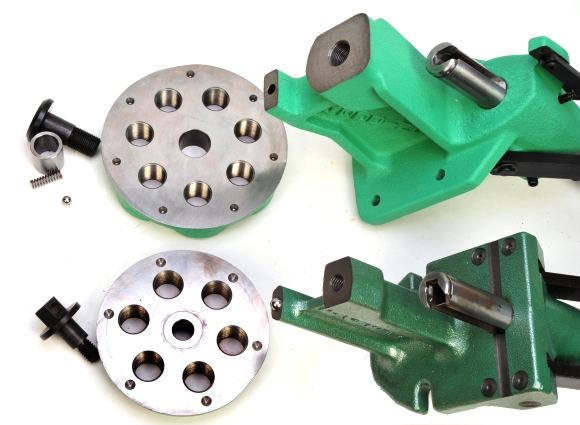
Pulling the turret heads from both presses reveals further differences between the two presses in design and strength. The bosses that support the center and trailing edge of the turret are nearly twice as large on the Redding press and the press body construction is much heavier with larger reinforcing ribs to make the overall assembly more rigid. While both presses use a shoulder bolt to centrally locate their respective turrets, the Redding press adds a steel bushing to provide additional bearing surfaces and to increase the surface area that minimizes turret movement off of its horizontal plane. When the press ram forces a cartridge into contact with a die, it attempts to raise the leading edge of the turret head and lower the trailing edge. To whatever degree that movement occurs, the die is moved out of axial alignment with the in-process cartridge.

The Lee Precision Classic Turret Press is quite different in design from either the RCBS or Redding press. The Classic’s base is cast iron, but a triangulated arrangement of three 0.625″ steel struts replace the heavy cast press body. The struts terminate at the top of the press with a steel turret retaining ring. The aluminum turret is only 3″ in diameter and accommodates a maximum of four dies or accessories. The turret is held in position within the retainer and supported about its perimeter with 4 major and 8 minor radial locking lugs. The Lee’s ram is the largest in diameter of the three presses represented. The long handle and heavy steel linkage provides the highest mechanical advantage within the group. With an indexing rod optionally installed in the press, it automatically advances the turret with each pull of the handle, following a fixed process sequence.
 The shift in the turret’s resistance to ram loading from a center bolt arrangement typical to turret presses to a series of locking lugs arranged in a radial fashion about the turret’s perimeter, minimizes the horizontal rocking experienced with center turret bolt presses and theoretically keeps the die in more perfect vertical alignment with the shell holder. If there is a weakness in the Lee locking lug approach it may be in the minimal lug engagement where surfaces intended to prevent turret lift are only 20% of the surface area found on the other two referenced presses. That said, I have never heard of Lee turret lugs shearing under pressure.
The shift in the turret’s resistance to ram loading from a center bolt arrangement typical to turret presses to a series of locking lugs arranged in a radial fashion about the turret’s perimeter, minimizes the horizontal rocking experienced with center turret bolt presses and theoretically keeps the die in more perfect vertical alignment with the shell holder. If there is a weakness in the Lee locking lug approach it may be in the minimal lug engagement where surfaces intended to prevent turret lift are only 20% of the surface area found on the other two referenced presses. That said, I have never heard of Lee turret lugs shearing under pressure.
If anything surprises me about the Classic Turret press it is that it measures a lot larger than it looks. As an example, while it is the most narrow of the presses I’ve referenced, it also has the largest ram diameter and highest mechanical advantage.
If the Lee press holds downsides for me they are in three areas. Limited die count capacity all but eliminates the possibility of running multiple die sets in the same turret head. The very close fit between dies makes individual die adjustment difficult and makes fitting some other manufacturer’s die lock rings impossible. Finally, the low mass and light weight construction makes operator effort feel high even with the benefit of high mechanical advantage. I have and still do use this press in my own efforts, but it is not my primary. If I didn’t have room to spread out, if my handloading activity was reduced, or if I were on a tighter budget, I’d reconsider. It is a great press when equipment needs to be moved around a bit, and it offers a lot of large cartridge loading capacity.
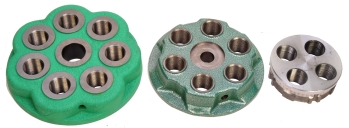
I’ve heard handloaders talk about turret presses not indexing correctly or not consistently lining a die up over a shell holder…mostly from single stage press users who don’t like the number or complexity of turret press moveable assemblies. So it seemed reasonable to check.
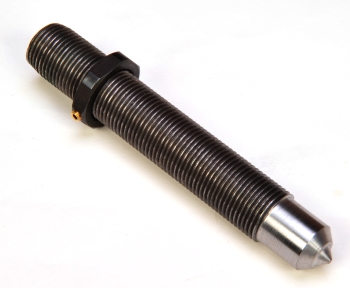
This tool was made to double check precision of any presses that indexed dies or shell holders. It could have been a little fancier, but it works fine. Fabricated from a piece of 7/8″x14 threaded rod, it was lathe-turned at the end into a straight shaft and two angle cuts. The rod is screwed into a press die station, first with the ram raised, then with the ram lowered, until it is in near contact with an installed shell holder. The larger diameter taper shows alignment to the shell holder’s shoulders, the smaller angle cut checks alignment to the primer hole in the center of the shell holder. The lock ring is used to square the tool to the die station boss just as it would when a die is mounted in a press.

I impressed myself with…myself by making this tool and proving, conclusively, that left alone in the shop with a lathe and scrap metal, I can waste more time than almost any individual on the face of the earth. Of course I did not know I would be setting that record until after I was told I was competing. Press castings may walk and bosses my shift, but whoever is in charge of drilling and tapping these die holes has uncanny knowledge of exactly where the center of a shell holder should be and exactly where to tap that die hole to arrive at the same location. I couldn’t find more than a few thousandths of an inch off center on any of these presses and most of this was the result of movement allowed by acceptable tolerances. Considering a .45-70 Gov’t case secured by any standard shell holder, in any press, can be made to wiggle more than 0.080″ at the top of the case with light finger pressure, the die to shell holder alignment in all of these presses is exceptional.
“Unable to find glaring functional differences, Joe went
to the basement and built a comparison table…”
| Dimensions & Characteristics | Redding T7 | RCBS Turret | Lee Classic Turret |
| MSRP | $408 | $264 | $140 |
| Press Type | Turret | Turret | Turret |
| Press Weight – Lbs | 25 | 17 | 12.5 |
| Indexing | Manual | Manual | Manual/Auto |
| Frame Material | Cast Iron | Cast Iron | Cast Iron/Steel |
| Turret Material | Cast Iron | Cast Iron | Aluminum |
| Turret Retention Support Area | 1.8 sq.in. | 1.8 sq.in. | 0.3 sq. in. |
| Die Size | 7/8″x14 | 7/8″x14 | 7/8″x14 |
| # die stations | 7 | 6 | 4 |
| Turret Support | Center | Center | Perimeter |
| Space between dies | 0.75″ | 0.70″ | 0.5″ |
| Clearance under turret | 4 1/2″ | 4 3/4″ | 4 1/2″ |
| Ram stroke | 3 13/16″ | 3 7/8″ | 3 7/8″ |
| Ram Diameter | 1″ | 1″ | 1 1/8″ |
| Ram bearing surface Area | 12.2 sq.in | 12.5 sq.in. | 11.3 |
| Mechanical advantage | 5.4:1 | 4.0:1 | 6.0:1 |
Of course, if you’re making an assessment of reloading presses and you’ve worn out your micrometers, dial indicator and instant video replay capabilities, you can always make some ammo and see how that works out. Now who’s the sharpest pencil in the box?. I broke out some .243 Winchester brass, some Hornady 100 grain soft pointed and boat tailed bullets, cracked my knuckles, tuned up and warmed up, and proceeded to knock off twenty rounds of ammo from each press. From each of these groups a statistically insignificant 5 rounds were randomly selected, measured and the results documented. A single set of RCBS dies and shell holder were used with all press for assurance variations were not die or shell holder related.
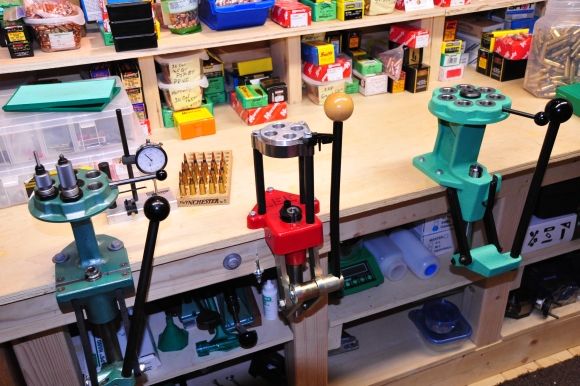
One of these days I have to save up for a perspective correcting lens. Doesn’t it look like the outside equipment is getting ready to tip over? Hey, there’s the milling machine indexing vise! I was wondering where that went. Anyway…
|
Redding |
|||||
| COL – Comparator | 2.182 | 2.180 | 2.180 | 2.181 | 2.180 |
| Neck Run Out | <0.001 | <0.001 | <0.001 | <0.001 | <0.001 |
| Bullet Run Out | <0.001 | <0.001 | <0.001 | <0.001 | <0.001 |
|
RCBS |
|||||
| COL – Comparator | 2.190 | 2.190 | 2.190 | 2.190 | 2.189 |
| Neck Run Out | <0.001 | <0.001 | <0.002 | <0.001 | <0.002 |
| Bullet Run Out | <0.001 | <0.001 | <0.001 | <0.001 | <0.001 |
|
Lee Precision |
|||||
| COL – Comparator | 2.181 | 2.182 | 2.182 | 2.182 | 2.183 |
| Neck Run Out | <0.002 | <0.001 | <0.002 | <0.001 | <0.002 |
| Bullet Run Out | <0.001 | <0.001 | <0.001 | <0.001 | <0.001 |
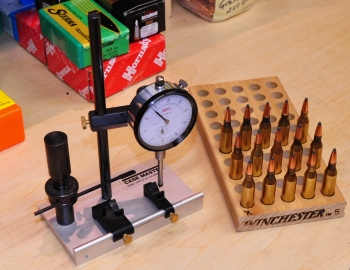
Basically, there was nothing here I would throw away. I think the results speak well for the state of modern tools and equipment. When I began reloading as a youngster, getting below 0.006″ bullet concentricity was worth celebrating, In fact, in the early days, it was this consistent lack of concentricity that forced me to take shots only at deer standing uphill and to my left.
While making ammo, I couldn’t help but make some general press operating observations. Of the three presses, the RCBS required the most effort to operate, both case forming and when pulling the expander back through the case mouth. The Lee Precision press felt pretty good, but it was easier for me to put the two dies in opposing turret stations than to try to squeeze them in right along side one another in the undersized turret. The Redding press was the smoothest of all and felt to be the easiest to operate, even though it did not have the highest theoretical mechanical advantage. The wide, deep mount pad on the Redding press spread the load around more than the others, so it felt stable and solid bolted to the bench. I have been a satisfied user of an RCBS turret for a long time so I was surprised by the difference in feel when running all presses side by side. The cartridges coming off the Redding were so concentric I had to keep checking the dial indicator to make sure it was working properly.
At the conclusion…

When the dust settled, and there is lots of dust in this place to settle, I owned a Redding T-7. Which is interesting, as I wasn’t shopping for a press when I began writing this piece. Most if the reasoning behind the decision was application specific.
We do some loading of some rather acutely wildcat cartridges that utilize multiple forming, loading and reamer dies. The seven stations of the Redding provides enough capacity to run each process in its entirety without changing the dies installed in the turret head. Also, the extra space between dies for finger room was appreciated.
The press felt effortless in operation; a combination of good mechanical advantage and cast iron mass momentum. Priming was uniform.
While all of the presses had the strength to do the job. I felt the extra extra beef in the press body, turret and the addition of a turret bolt bushing would add to the press’ longevity and consistency of operation.
I like the color.
Resources when purchasing equipment…
Virtually every equipment manufacturer publishes detailed specifications and capacities in product brochures, if not right on their respective web sites. It’s OK to ask and to make sure equipment fits your needs before purchasing. Quality retailers, as a resource, make all the differences in the world. One of my great frustrations with Internet purchases is calling a large discounter’s sales or customer service representatives and having someone attempt to answer a technical question by reading a product description from the retailers web site…or never answering a clear and concise email question. So I purchase from people who actually handload, shoot firearms and can spontaneously answer fundamental questions and research the more technical.
Sinclair International, even more so now as a part of Brownells with an expanded line of precision shooting products, is a great source of reloading equipment and accessory and also an excellent technical resource. Great prices, excellent customer service and they are probably the only company offering products in a range appropriate from beginner to competitive shooter. It is a good group to help a novice get started, one that a handloader won’t outgrow as they develop expertise.
Handloading is a lot of fun. The effort can save money, bring a lot more enjoyment to hunting and competitive shooting and it is a great activity for people who like lots of precision and purposeful machinery. It can be challenging and it can be entertaining and there is always so much more to learn.
Handloading…The Wandering Narrative Part I
Handloading…The Wandering Narrative Part II
Handloading…The Wandering Narrative Part III

Email Notification